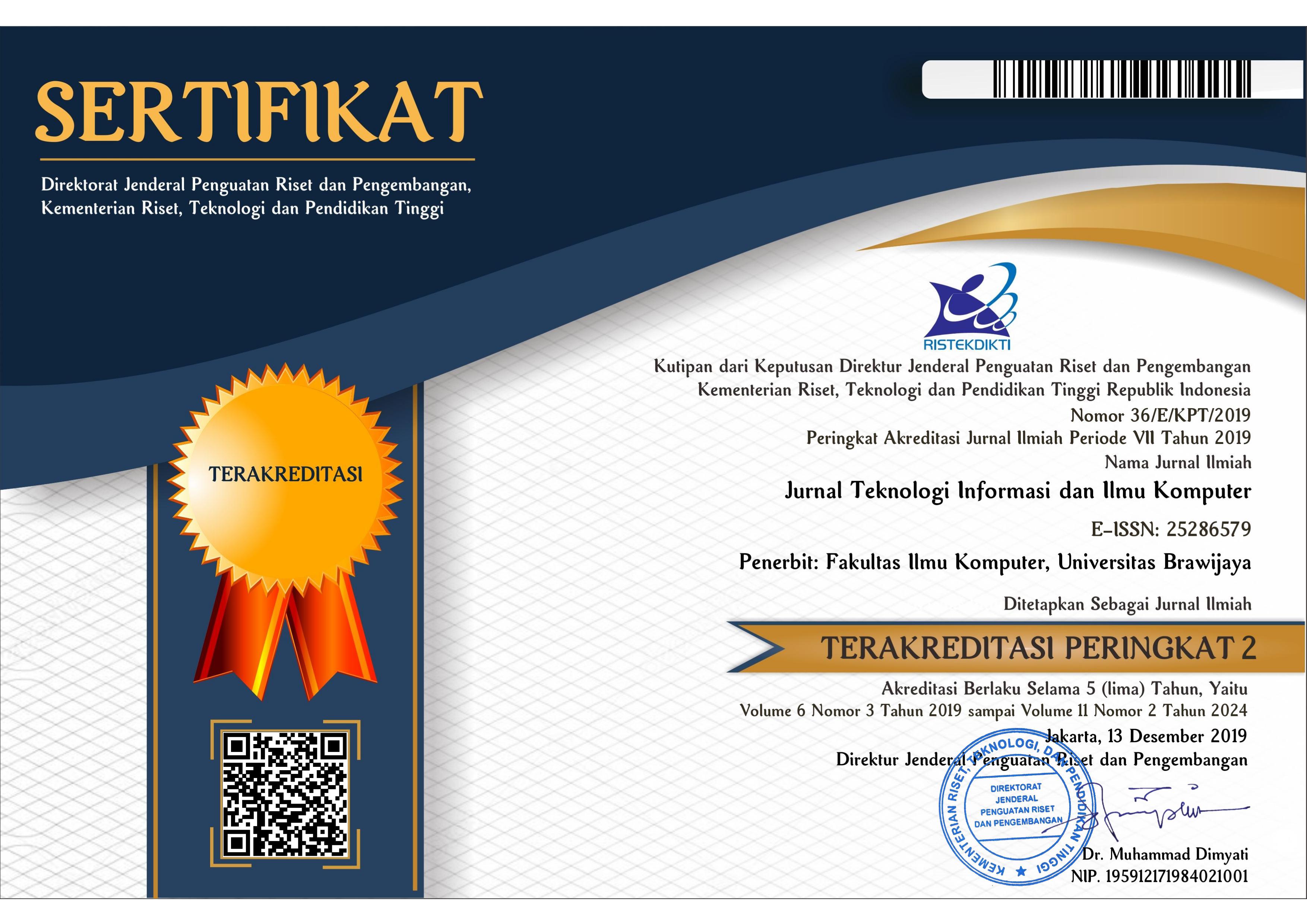Sistem Pendeteksi Central Sleep Apnea Menggunakan Metode Neural Network dengan Fitur RR Interval dan Durasi QRS
DOI:
https://doi.org/10.25126/jtiik.2022976758Abstrak
Penyakit Central Sleep Apnea (CSA) adalah gangguan tidur akibat otak gagal memberi tahu otot-otot untuk bernapas sehingga terjadi periode henti napas ketika tidur. Kondisi ini menganggu jumlah, kualitas atau durasi tidur seseorang dan memicu sumber masalah kelelahan di siang hari, masalah jantung, tekanan darah tinggi dsb. Standar diagnosis pemeriksaan kondisi CSA adalah polisomnografi yang terkenal terbatas. Sebab tingginya prevalensi Sleep Apnea dan kurangnya ketersediaan diagnosis pemeriksaan, juga dibutuhkan biaya yang relatif tinggi. Penelitian ini dilakukan untuk mengembangkan sistem portable dalam membantu mendeteksi penyakit CSA. Sinyal ECG jantung dimanfaatkan karena irama jantung berdetak secara berbeda saat periode henti napas tiba-tiba waktu tidur, yang telah dinilai membantu proses diagnosis. Sistem dirancang dengan mikrokontroller Arduino Uno, sensor AD8232 dan modul Bluetooth HC-05. Sensor sebagai pendeteksi aktifitas listrik jantung, dengan 3 buah elektroda menempel pada dada untuk merekam lalu diekstraksi fitur RR interval dan durasi QRS. Kedua fitur pada 18 set data uji diklasifikasi dengan metode Neural network, keluarannya berupa kelas Normal atau Apnea ditampilkan pada smartphone dengan konektivitas Bluetooth. Pengujian kinerja sistem untuk deteksi sensor memperoleh nilai 96.18%, dan presentase akurasi klasifikasi Neural Network menghasilkan 83.3% dengan waktu komputasi 46.44 ms.
Abstract
Central sleep apnea (CSA) is a sleep disease in which the brain fails to send signals to the muscles to breathe, resulting in periods of no breathing during sleep. This disorder interferes with a person's sleep quantity, quality, or duration, which can lead to daytime weariness, heart difficulties, high blood pressure, and other issues. Polysomnography is the primary diagnostic technique for Central Sleep Apnea, yet it is notoriously restricted. The expenditures are relatively expensive due to the high incidence of sleep apnea and the paucity of diagnostic methods. The goal of this study was to create a portable device for detecting CSA illness. It has been evaluated to help in the diagnosing process and uses cardiac ECG data since the heart rhythms alter during periods of abrupt stoppage during sleep. The Arduino Uno microcontroller, AD8232 sensor, and HC-05 Bluetooth module are used in the system. With three electrodes attached to the chest to record and then extract the RR interval and QRS duration properties, the sensor is used to monitor the electrical activity of the heart. The Neural network technique classifies the two properties in the 18 test data sets, and the output in the form of Normal or Apnea classes is shown on a smartphone with Bluetooth connectivity. The sensor detection system performance test yielded a result of 96.18%, and the percentage accuracy of Neural Network classification was 83.3% with a processing time of 46.44ms.
Downloads
Referensi
ABIODUN, O. I., JANTAN, A. & OMOLARA, A. E., 2018. State-of-the-art in artificial neural network applications: A survey. Heliyon, 4(11).
ARIKAWA, T. et al., 2019. Clinical Usefulness of New R-R Interval Analysis Using Heart Rate Sensor WHS-1 to Identify Sleep Apnea Syndrome (SAS). Circulation, Volume 140.
AURORA, R. N. et al., 2012. The Treatment of Central Sleep Apnea Syndromes in Adults: Practice Parameters with an Evidence-Based Literature Review and Meta-Analyses. SLEEP, 35(1), pp. 17-40.
BENISEK, A., 2021. WebMD. [Online]
Available at: https://www.webmd.com/sleep-disorders/sleep-apnea/sleep-apnea
[Accessed 1 March 2022].
BUTTNER, R. & CADOGAN, M., 2022. LITFL - Life in the FastLane. [Online]
Available at: https://litfl.com/fontaine-lead/
[Accessed 27 03 2022].
CULEBRAS, A. & ANWAR, S., 2018. Sleep Apnea is a Risk Factor for Stroke and Vascular Dementia. Curr Neurol Neurosci Rep.
EDITORIAL TEAM, 2019. Towards Ai. [Online]
Available at: https://towardsai.net/p/data-science/how-when-and-why-should-you-normalize-standardize-rescale-your-data-3f083def38ff
[Accessed 18 10 2022].
FAHRUZI, I., PURNAMA, I. K. E. & PURNOMO, M. H., 2020. Asesmen ECG-Apnea Satu Sadapan untuk Peningkatan Akurasi Klasifikasi Gangguan Tidur Berdasarkan AdaBoost. Jurnal Nasional Teknik Elektro dan Teknologi Informasi | Vol. 9, No. 2, pp. 196-204.
HASIBUAN, R. K. & HASNA, J. A., 2021. Gambaran Kualitas Tidur pada Lansia dan Faktor-Faktor yang Mempengaruhinya di Kecamatan Kayangan, Kabupaten Lombok. Jurnal Kedokteran dan Kesehatan, 17(2), pp. 187-195.
HUNG, P. D., 2018. Detection of Central Sleep Apnea Based on a Single-Lead. ICBRA '18: Proceedings of the 2018 5th International Conference on Bioinformatics Research and Applications, pp. 78-83.
MILLER, S., 2020. Analog vs. Digital Filtering of Data. ECE Senior Capstone Project.
PILLAR, G. et al., 2020. Detecting central sleep apnea in adult patients using WatchPAT—a multicenter validation study. Sleep and Breathing, Volume 24, pp. 387-398.
SAYIN, M. R. et al., 2015. Presence of Fragmented QRS Complexes in Patients with. Chinese Medical Journal, 128(16), pp. 2141-2146.
SETIAWIDAYAT, S., 2020. Penentuan Posisi Awal dan Akhir Gelombang ECG tiap Siklus Menggunakan Algoritma PQRST. Conference on Innovation Application of SCience and Technology (CIASTECH), pp. 589-696.
Unduhan
Diterbitkan
Terbitan
Bagian
Lisensi

Artikel ini berlisensi Creative Common Attribution-ShareAlike 4.0 International (CC BY-SA 4.0)
Penulis yang menerbitkan di jurnal ini menyetujui ketentuan berikut:
- Penulis menyimpan hak cipta dan memberikan jurnal hak penerbitan pertama naskah secara simultan dengan lisensi di bawah Creative Common Attribution-ShareAlike 4.0 International (CC BY-SA 4.0) yang mengizinkan orang lain untuk berbagi pekerjaan dengan sebuah pernyataan kepenulisan pekerjaan dan penerbitan awal di jurnal ini.
- Penulis bisa memasukkan ke dalam penyusunan kontraktual tambahan terpisah untuk distribusi non ekslusif versi kaya terbitan jurnal (contoh: mempostingnya ke repositori institusional atau menerbitkannya dalam sebuah buku), dengan pengakuan penerbitan awalnya di jurnal ini.
- Penulis diizinkan dan didorong untuk mem-posting karya mereka online (contoh: di repositori institusional atau di website mereka) sebelum dan selama proses penyerahan, karena dapat mengarahkan ke pertukaran produktif, seperti halnya sitiran yang lebih awal dan lebih hebat dari karya yang diterbitkan. (Lihat Efek Akses Terbuka).








